Ireland & the European Reformation
Published in Early Modern History (1500–1700), Features, Issue 4 (Winter 1998), Volume 6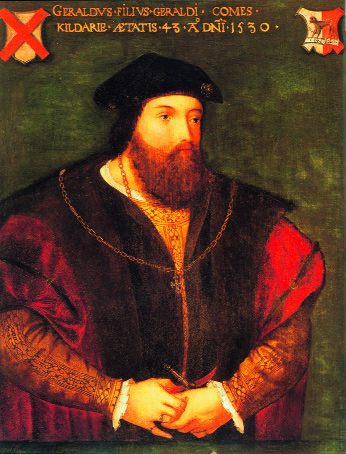
Gerald í“g Fitzgerald, ninth Earl of Kildare-had he a Luther in his chapel, who knows what might have happened… (His Grace the Duke of Leinster)
The Protestant Reformation is one of the great events of European history, and assessing its causes, nature, meaning and consequences is a habitual challenge. Yet in Ireland, as in other parts of Europe such as Italy and Spain, where the Protestant Reformation ‘failed’, it is a subject of some awkwardness. What Reformation? How does one investigate something that—because it was not accepted by the majority of the population—essentially did not happen?
In the case of Ireland the awkwardness is accentuated when the event is considered—as it customarily is—within the framework of the ‘British Isles’, that unsatisfactory appellation for which there is still no satisfactory substitute. In that framework, Ireland is exceptional: the only one of the kingdoms of the British monarchy in which the Protestant Reformation did not, for all practical purposes, ‘succeed’—although it did temporarily succeed as the religion of the state church and of the Protestant ascendancy into the early nineteenth century. To be sure, Roman Catholicism survived in England, Wales, and Scotland to a greater extent than used to be admitted; but only in Ireland did it endure and revive as the religion of the great majority.
The magisterial, or state-made Reformation
The foundation principle of the Reformation in the territories of the Holy Roman Empire was, almost universally, cuius regio, eius religio, the so-called ius reformandi, meaning that the religion of the relevant local prince dictated the religion of his or her subjects. Religious uniformity was passionately sought by the princely and the pious in an age which recognised only one true way, and treated all others as dangerous delusions or heresy. But no one should underestimate the difficulty of changing religious beliefs, practices, or identities.
Therefore, variety could in practice not always be prevented and often became a fact of life. The history of early modern Europe reveals not only bitter and often brutal religious conflicts, but also grudging accommodations leading eventually to toleration and pluralism. The centrepieces of this tradition both celebrate an anniversary in 1998: the Edict of Nantes (1598-1685) which temporarily granted a modicum of toleration to Protestants (Huguenots) in France, and the Peace of Westphalia (1648) which made provision for legal, multiple, religious practices within the Holy Roman Empire and its territories.
We need to appreciate the great difficulty of enforcing cuius regio, eius religio and to understand that ‘success’ was not guaranteed and that resistance was frequent. We need also to understand the degree to which religious issues were often mingled with purely secular ones concerning rights, power, and wealth. In the past fifty years, and even more-so in the past twenty, historians have looked at the minutiae of religious crisis and change in the two centuries after Luther. The focus has been less on the thought and career of such heroic figures as Luther, Zwingli, Calvin, or Loyola, and more on the actual struggles within particular cities and states.
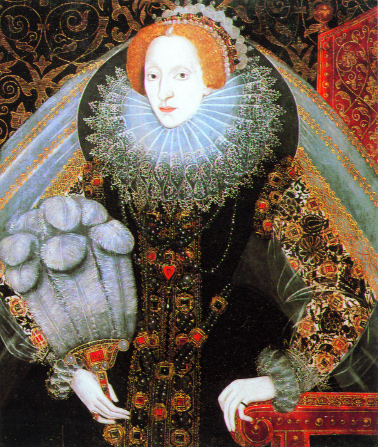
Queen Elizabeth I-the Protestant monarchs of post-Reformation England were not alone in Europe when they found their choice of religion rejected in Ireland. (National Portrait Gallery, London)
Moreover, the historiography of the Reformation is moving away from the traditional division along the confessional lines so prominent in the nineteenth and early twentieth centuries. Comparative aspects are more frequently stressed, whether between different European states or between the different confessional churches which developed. Building on this new wealth of Reformation micro-studies, we wish to compare the Reformation in Ireland with events in Wales, Gaelic Scotland, Norway, and two territories of the German Empire.
The Irish ‘exception’ in the context of the British Isles
The Reformation in England proceeded unambiguously from its monarchs—Henry VIII, and then two of his three children, Edward and Elizabeth—and it aimed at enforcing cuius regio, eius religio. The English monarchs confronted the daunting task of imposing their personal choice on a large, diverse, and in some cases remote, population in England, Wales and Ireland. That they succeeded for the most part in England and Wales remains beyond doubt, although the manner and extent of their success is still vigorously debated.
The richest part of the legacy of the Tudor historian Geoffrey Elton is the seriousness with which he took the processes by which Henry VIII and Thomas Cromwell achieved, at least in England, a high degree of nominal acceptance of their radical changes. And in the neighbouring Scottish kingdom (which shared its monarchs with England from 1603), a Protestant church, whatever its differences from the Church of England, was resolutely established by the end of the sixteenth century.
In Ireland, British monarchs faced obstacles which proved insuperable and which resulted in the most enduring and disruptive religious division in the realm. Because this happened only in Ireland, and because the Counter-Reformation—Rome’s own renascence and renewal—found such fertile soil there, it has often been assumed that Ireland was the most profoundly ‘Catholic’ portion of the archipelago; that there was something elemental or congenital in its conservatism and resistance to innovations in church, liturgy and theology.
But the history of the Reformation in England has undergone its own rather dramatic ‘revision’ (particularly in the work of Eamon Duffy), and the result is a view of that kingdom as extraordinarily pious and observant on the eve of the Reformation. On the basis of popular religiosity, therefore, England may have been no more disposed to the Protestant Reformation than Ireland. The success of the Reformation in Wales suggests what might have happened in the cross-channel kingdom, and it was the model many late-Tudor statesmen hoped to apply. Wales, like Ireland, was a poor and remote Celtic borderland. The fact of the Reformation’s success in Wales, where it was early propagated both orally and through printing in the Welsh language, suggests that Irish Gaelic culture was also not necessarily incompatible with Protestant reform. The Highlands and Islands of Scotland afford another example of a Gaelic-speaking area within the British Isles where substantial elements of the population were effectively proselytised to Calvinism, and with little help from the printing press. This suggests that Protestant doctrine was quite capable of spreading orally through Gaelic-speaking societies.
Alien reform in an alien tongue
A reason often given for the failure of Protestantism in Ireland is that it was imposed by a foreign power in a foreign language. But both of these conditions also obtained in Norway, where the Reformation clearly succeeded. Difference between the language of the prince—who was Danish—and his subjects—who spoke Norwegian—did not prevent the Protestant Reformation in Norway. Denmark, to which Norway was joined as a dependent territory, much as Ireland was joined to England, early became Lutheran. In 1536 the Danish king imposed his personal faith on his Norwegian subjects in an unfamiliar tongue. True, the new faith was not greeted enthusiastically in Norway and there was resistance. Yet Protestantism eventually succeeded, despite the fact that it was identified with an alien monarchy and was propagated in the foreign language of that power. Ultimately the Protestant Reformation was so successful in Norway that the country is today as much identified with Lutheranism as Ireland is identified with Roman Catholicism. Norway is thus an example of the Reformation’s ‘success’ in circumstances similar to those in Ireland. The Danish kings were foreign rulers who successfully enforced cuius regio, eius religio on Norway without adapting the Reformation to the language and culture of that territory.
Continental counterparts
If, with regard to the outcome, that is, the failure of the Reformation, Ireland is peculiar within the archipelago as well as in comparison with Norway, it has previously little-noticed parallels in continental Europe. There, we can find other states where the religious preference of the prince was resisted, and even, as in Ireland, rejected. It is in Germany that we find examples of princes who were unable to enforce the ius reformandi, their legal right to dictate religion, and it is in Germany that we find examples of states where the will of the prince in the matter of religion did not prevail. In both our German cases a Calvinist ruler acquiesced before his Lutheran subjects, a phenomenon—mutatis mutandis—that historians have often regarded as peculiar to Ireland.
Brandenburg is a German state well known for its eighteenth-century militarism, but also for its tolerance towards French Huguenots in the late seventeenth century. However, this tolerance developed only after an abortive attempt by the Hohenzollern Elector of Brandenburg to enforce the ius reformandi on the subjects of his territory. Close to Luther’s Saxony, Brandenburg was slow to be influenced by the Wittenberg reformer, but by the 1570s the people of Brandenburg had become firmly Lutheran. On the other hand, in 1613 Elector John Sigismund (1658-1619) personally converted to Calvinism and set about the Calvinisation of his territory. He was soon to be sorely disappointed. Like Henry VIII more than seventy years before, and like many other princes in the sixteenth and seventeenth centuries, the Elector’s religious reforms were part of a package of innovations which were intended to enhance his powers. Just as religious change in Ireland was associated with the expansion of princely power, so Hohenzollern Calvinism was freighted with the dynasty’s worldly ambitions.
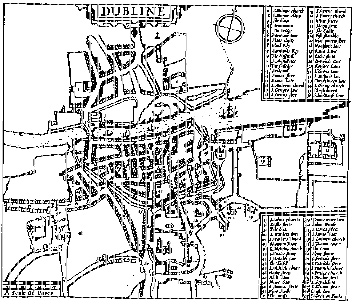
John Speed’s map of Dublin, 1610-Dublin is sometimes seen as anomalous in a preponderantly rural Ireland, but it had much in common with the Hanseatic town of Lemgo in Northern Germany.
From the point of view of the Brandenburg estates, particularly the Junker nobility, the Elector’s political and confessional programs merged into one obnoxious princely agenda, and the nobles energetically resisted it with all the means at their disposal. Religion came to serve as a rallying point for opposition to the prince: the estates’ Lutheranism had fused with ancient rights and traditions to become a rallying cry against princely intrusion, much as Roman Catholicism had dignified and concentrated the resistance of the threatened nobility in Ireland. In 1615, two years after his conversion to Calvinism, John Sigismund abandoned his effort to propagate his personal faith among his people. His successors acquiesced in this stunning retreat, and the Hohenzollerns and their court were all that remained Calvinist in Lutheran Brandenburg.
In Ireland it was not just the nobility that rejected the Reformation: the resistance of the Old English people and gentry to the introduction of the new faith and their stubborn adherence to Roman Catholicism took contemporaries by surprise, and still strikes modern historians as distinctive. But in a continental context, this resistance to cuius regio, eius religio was not unusual.
At the beginning of the seventeenth century, the middle-sized Hanseatic town of Lemgo in the territory of Lippe, which had become Lutheran in the 1530s, was confronted with a ruler who converted from Lutheranism to Calvinism. Count Simon VI (1563-1613) tried to impose a Calvinist church on his territory, including its principal town of Lemgo.
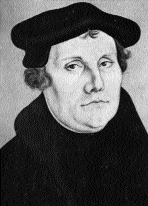
Unlike Nuremberg or Frankfurt, Le
Unlike Nuremberg or Frankfurt, Lemgo was neither a free nor an imperial city, and it was therefore in theory (and after 1555 in law) subject to the ius reformandi of the hereditary counts of Lippe. But Count Simon failed in his attempt to bring his subjects into conformity with his religious convictions. In a long drawn-out suit in the imperial courts Lemgo, although formally a territorial town, eventually won its case and managed to remain both autonomous and Lutheran, despite the wishes of its prince.
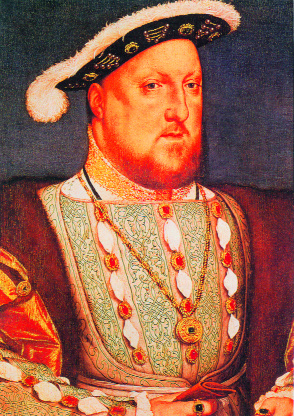
Henry VIII by Hans Holbein-if matrimonial disorder had not driven him down the path of schism, what curiosities might have been seen in Ireland. (Thyssen-Bornemisza Collection/Bridgeman)
Lemgo was similar to Dublin and other Old English towns at the end of the sixteenth and the beginning of the seventeenth centuries. In both Lemgo and Dublin an urban elite resisted princely encroachment on grounds that were seen as ‘ancient liberties’ and ‘civic religion’, even though in Dublin it was Roman Catholicism and in Lemgo it was Lutheranism that was defended as ancient and traditional. The point is that any faith could become the religious banner to which local elites rallied and from which they claimed to resist princely authority, whether in political or religious matters. And not every ruler could successfully impose on his subjects his personal religious views. The Protestant monarchs of post-Reformation England were thus in good company when they found their choice of religion rejected in Ireland.
Conclusion
No one doubts the vigour with which Roman Catholicism—especially as strengthened after Trent—played the role of rallying point in Ireland. Our conclusion is rather that it was not some special or distinctive quality in Irish Catholicism which explains effective Irish resistance to the ius reformandi of the Protestant Tudors and their heirs. On the contrary, we find that resistance to religious innovation ‘from above’ was common in sixteenth- and seventeenth-century Europe, and not, therefore, extraordinary in Ireland.
Frederick, Elector of Saxony, as a young prince created one of the largest collections of sacred relics in Europe, yet he became after 1517 the patron and protector of Luther. Had Gerald, ninth Earl of Kildare (1487-1534) and Lord Deputy of Ireland, a Luther in his chapel, he might have been equally tempted to follow a reformist path. And if the matrimonial disorder of his monarch, Henry VIII, had not driven that ruler down the path of schism, what curiosities might have been seen in Ireland! In that circumstance a devoutly Catholic English king—already, in 1521 proclaimed Defensor Fidei by a grateful Papacy—could have found himself struggling (with Papal blessing) to expand his power over a ‘wild and heretical people’ in Ireland. In a European comparative framework the undoubted Catholicism of modern Ireland—like the religious character of other parts of Europe—appears a product of its relatively recent past, not some immemorial racial or ethnic character, unchanging and predestined.
Karl S. Bottigheimer is Professor of History at the State University of New York, Stony Brook. Ute Lotz-Heumann teaches history at the Humboldt University, Berlin.
Further reading:
R. Scribner, R. Porter, M. Teich (eds.), The Reformation in National Context (Cambridge 1994).
A. Ford, The Protestant Reformation in Ireland (Dublin 1997).
C. Lennon, The Lords of Dublin in the Age of Reformation (Dublin 1989).
B. Nischan, Prince, People and Confession: The Second Reformation in Brandenburg (Philadelphia 1994).
















